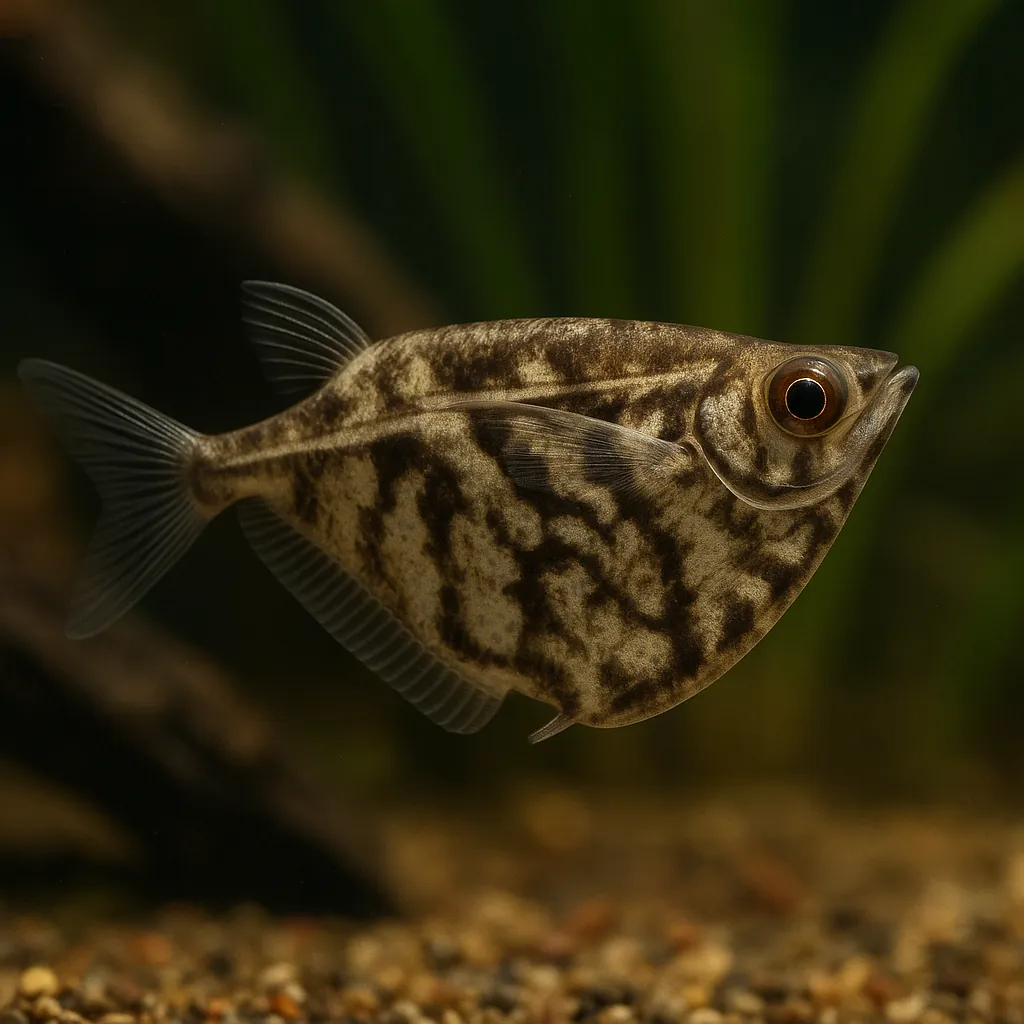
Marbled hatchetfish
Introduction
The Marbled Hatchetfish (Carnegiella strigata) is a distinctive freshwater species cherished by aquarists for its unique body shape and peaceful demeanor. Native to South America's slow-moving streams and flooded forests, this fish is renowned for its ability to "fly" above the water's surface, a behavior that adds intrigue to any aquarium. While they are relatively easy to care for, Marbled Hatchetfish require specific conditions to thrive, making them suitable for aquarists with some experience.
What makes the Marbled Hatchetfish unique?
Their hatchet-shaped bodies and ability to glide above the water's surface set them apart from other freshwater species.
Are Marbled Hatchetfish suitable for beginners?
Due to their sensitivity to water conditions and specific care requirements, they are better suited for aquarists with some experience.
Care and Environment
Providing the right environment is crucial for the health and well-being of Marbled Hatchetfish. Here's a comprehensive guide to their care:
What is the minimum tank size for a Marbled Hatchetfish?
A minimum of 20 gallons (approximately 75 liters) is recommended to accommodate a small group and provide ample swimming space.
What are the ideal water parameters?
Maintain a temperature between 75°F and 82°F (24°C to 28°C), a pH of 5.5 to 7.0, and water hardness of 2 to 12 dGH.
How should the tank be set up?
Use a dark substrate with plenty of floating plants to provide cover and mimic their natural habitat. Ensure the tank has a tight-fitting lid, as Marbled Hatchetfish are known jumpers.
What should I feed my Marbled Hatchetfish?
They are carnivorous surface feeders. Offer a varied diet of high-quality flake foods, small insects, and live or frozen foods like daphnia and brine shrimp.
Are there any specific challenges in keeping Marbled Hatchetfish?
They are sensitive to water quality and can be prone to diseases like ich. Regular water changes and monitoring are essential. Additionally, they can be territorial with their own kind, so careful observation is needed when keeping them in groups.
Origin and Habitat
Marbled Hatchetfish are indigenous to the slow-moving streams and flooded forests of the Amazon Basin in South America. They thrive in areas with dense surface vegetation, which provides both food and protection from predators. The water in these regions is typically soft and acidic, with temperatures ranging from 75°F to 82°F (24°C to 28°C).
Where are Marbled Hatchetfish found in the wild?
They are native to the Amazon Basin's slow-moving streams and flooded forests.
What type of environment do they prefer?
They favor areas with dense surface vegetation, soft acidic water, and temperatures between 75°F and 82°F (24°C to 28°C).
Temperament and Compatibility
Marbled Hatchetfish are generally peaceful and can be a great addition to community tanks. However, they can exhibit territorial behavior, especially towards their own species. It's advisable to keep them in groups of six or more to promote natural behavior and reduce stress. Suitable tank mates include small, non-aggressive species like tetras, rasboras, and dwarf cichlids. Avoid housing them with larger or more aggressive fish that might outcompete them for food or space.
Are Marbled Hatchetfish aggressive?
They are generally peaceful but can be territorial, especially towards their own kind.
What are suitable tank mates for Marbled Hatchetfish?
Small, non-aggressive species like tetras, rasboras, and dwarf cichlids are ideal.
Should Marbled Hatchetfish be kept in groups?
Yes, keeping them in groups of six or more is recommended to promote natural behavior and reduce stress.
Interesting Facts
Marbled Hatchetfish possess several fascinating traits that make them stand out:
- They have a unique ability to glide above the water's surface, a behavior known as "skipping," which helps them evade predators.
- Unlike many other hatchetfish species, Marbled Hatchetfish have been successfully bred in captivity, though it requires specific conditions and care.
- They are known for their distinctive hatchet-shaped bodies and marbled coloration, which provide camouflage in their natural habitat.
Can Marbled Hatchetfish fly?
They can't fly in the traditional sense but can glide above the water's surface to escape predators.
Is breeding Marbled Hatchetfish in captivity possible?
Yes, they have been successfully bred in captivity under specific conditions.
Sources
All information in this article has been gathered from the following reputable sources:
Overview
Recommended Tank Size 19.8 Gallons (for groups of 6 or more) |
Minimum Group Size 6 |
Minimum Tank Volume 19.8 Gallons |
Maximum Adult Length 2 inches |
Average Adult Length 1.6 inches |
Shoaling (6+ required) Yes |
Preferred Water Type Freshwater, soft, acidic |
Temperature Range (°C) 24–28 |
pH Range 5.5–7.0 |
Water Hardness (dGH) 2–12 |
Typical Lifespan (years) 2 years |